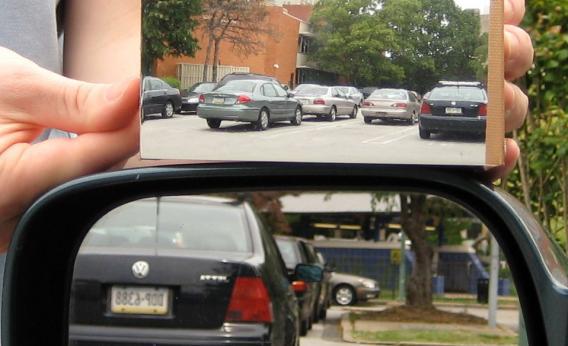After a decade of tinkering, a Drexel University mathematics professor has invented what’s being billed as the perfect driver’s-side car mirror. Subtly curved, it strikes a balance between the standard flat mirror—which, if not perfectly adjusted, leaves you with a dangerous blind spot—and the grossly rounded wide-angle mirrors you see on school buses, which seriously distort objects’ size and shape.
It’s a neat innovation, one that could potentially prevent a few of the roughly 90 deaths that happen every day on U.S. roadways. No doubt Drexel’s R. Andrew Hicks deserves praise for coming up with it. The interesting question is, why did it take a lone math whiz toiling in a lab for 10 years to perfect the side-view mirror? Shouldn’t the car companies have whipped it up long ago?
Coverage of Hicks’ mirror gizmo, patented last month, has mostly glossed over that question—which is unfortunate, because the answer is interesting.
As Hicks himself explained to me, the mirror isn’t necessarily better than the ones the manufacturers already make—just different. Unlike passenger side mirrors—which bear the famous slogan, “OBJECTS IN MIRROR ARE CLOSER THAN THEY APPEAR”—driver’s side mirrors are made flat in order to give the driver an accurate perception of objects’ size and distance. So objects in your driver’s side mirror are exactly as close as they appear. The blind spot is a potential downside, but it can be eliminated, or nearly eliminated, if you adjust the mirror properly.
Hicks’ mirror demolishes the blind spot, though at a cost: Like your passenger-side mirror, which is also curved (though not as intricately as Hicks’ prototype), it makes everything look a little smaller. The tradeoff might be worthwhile, but it would probably also take some getting used to.
His mirror, then, is most accurately viewed as an improvement over the existing wide-angle mirrors that you can buy at an auto-parts store. In that context, it seems a big leap forward: It shows you everything you’d want to see, without the fish-eye effect that makes everything look weird and curvy.
And why was Hicks able to do it when others didn’t? Part of it is surely his mathematical expertise—he came up with an algorithm that results in a surface ideally curved to capture a 45-degree view with minimal distortion.
But part of it was, he admits, blind luck. As it happened, he came up with the algorithm for the mirror at the same time that new machining technology made it possible to actually manufacture it. Old machining techniques could produce either flat mirrors or curved mirrors with a consistent radius, but only with newly developed freeform fabrication technologies could you quickly and precisely manufacture a “wavy” mirror, or one whose curvature is specified at every point. Hicks worked with a Canadian firm, B-Con Engineering, which uses a (literally) cutting-edge technique called “five-axis diamond turning” to fabricate complex surfaces based on computer programs.
“I kind of naively started working on this problem, not knowing that if I had done it 10 years earlier, it wouldn’t have been possible to really make it,” Hicks told me.
The lesson, then, isn’t that car manufacturers are too stodgy to innovate on their own. It’s that, in Hicks’ words, “We’re living in a golden age of fabrication,” where a math geek can dream up a consumer technology solution on a computer, publish a paper on it—and then go ahead and make it real.
